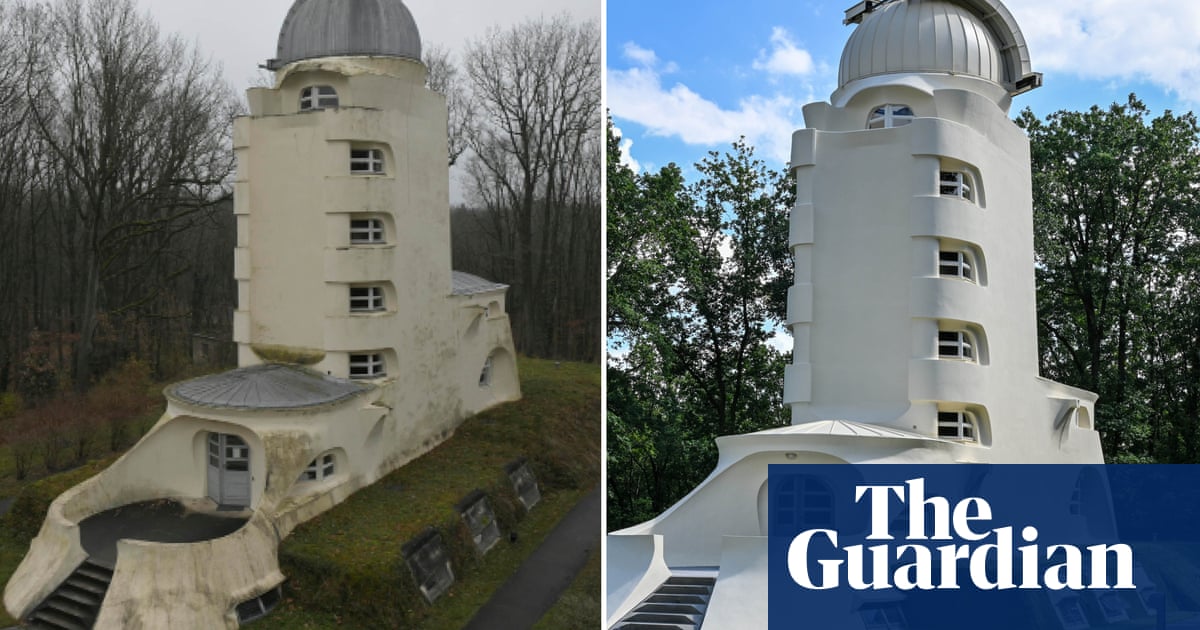
A solar observatory built to substantiate Albert Einstein’s theory of relativity has been reopened near the German capital after a renovation project to preserve it for future generations.
The Einsteinturm (Einstein Tower) on Telegraph Hill in Potsdam, 16 miles (25km) south-west of Berlin, spent a year under scaffolding while work was carried out using modern techniques to seal its many thousands of cracks, cure it of extensive dampness, and to save its domed zinc roof, while retaining its authenticity.
Constructed between 1920 and 1922 by the architect Erich Mendelsohn in collaboration with the astronomer Erwin Finlay-Freundlich, the 20-metre tower, said at the time to resemble a “gawky spaceship”, has long been a lure for architectural enthusiasts and astrophysicists alike.
Mendelsohn had intended his work to represent and facilitate Einstein’s relativity theory, arguing the tower had been inspired by “the allure around Einstein’s universe”.
The amorphous construction, the first major work by Mendelsohn who also applied his pioneering dynamic functionalist style elsewhere, is considered a landmark in expressionist architecture. It has no right angles, a curvaceous wooden staircase, and contains an elaborate system of mirrors and lenses that draw sunlight from the telescopes on the roof down to the spectrograph and observation laboratories in the basement.
The tower is very much still in operation as a working solar observatory today, run by the Leibniz Institute for Astrophysics (AIP), where it is mainly used for the study of solar magnetic fields.
It was originally planned in concrete. A lack of materials after the first world war, however, meant it was produced in stucco-covered brick, resulting in the building being structurally problematic from the start. It later suffered heavy damage during allied bombing in the second world war.
Hagen Mehmel, the project engineer who oversaw the renovations that cost about €1.2m (£1m) and required an estimated 10,000 hours of labour, called it a “fantastic structure – in my eyes it’s a sculpture, but from a structural engineering point of view it’s a fiasco”, speaking at the opening ceremony.
The tower was originally designed and constructed with the main purpose of verifying Einstein’s general theory of relativity, his groundbreaking theorem of motion, light and space, which he had published in 1911. It became particularly useful for measuring the phenomenon recognised in the theory of the slight movement of the spectral lines in the sun’s gravitational field, which is now referred to as the “red shift”.
Standing under the dome beneath a blue sky, Alexander Warmuth, the deputy head of the solar physics section of the AIP, pointed out that the telescopes he was operating were the original ones installed almost 100 years ago.
“The Einstein Tower might no longer be at the forefront of research but it’s not a mere museum piece,” he said. “It’s still very much in use to train students as well as developing and testing instrumentation for new bigger solar telescopes and testing.
“Following its renovation it’s probably now in a better condition than it was when it was inaugurated almost 100 years ago. As I spend a lot of time in its basement developing parts of an instrument on a spacecraft which is currently orbiting the sun, it’s very close to my heart.”
A digital exhibition has been launched to give more information to visitors, most of whom will only view the tower from the outside.
By all accounts, Einstein never showed much enthusiasm for the building. After Mendelsohn had eagerly taken him on a tour of it, he reportedly waited hours for a response from the scientist who later murmured the single-word conclusion: “Organic.”









